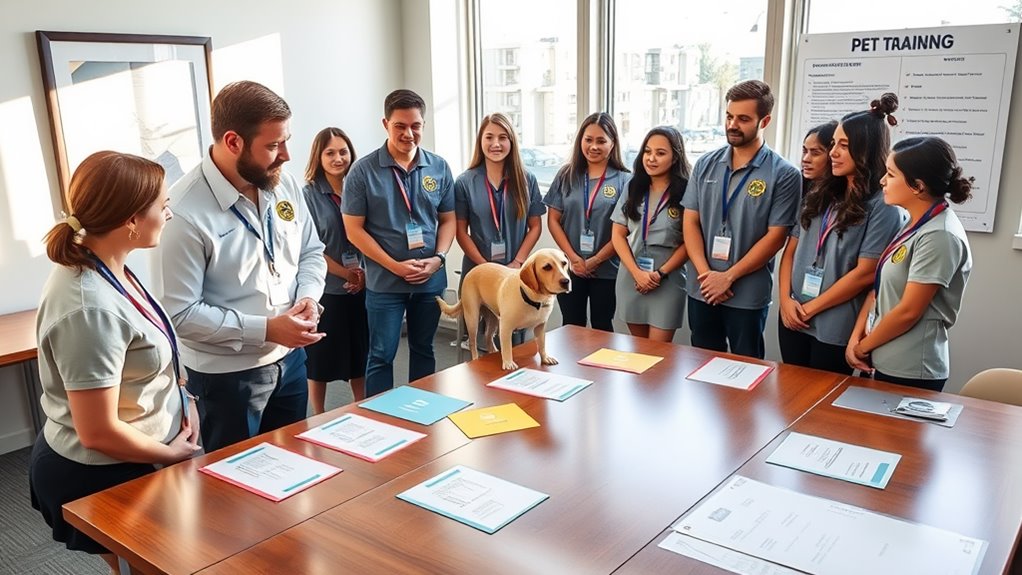Starting a pet sitting service in Singapore is like planting a seed in fertile soil, but it requires careful nurturing to grow. You'll need to navigate the local market, understand your competition, and define your target audience to make certain your service flourishes. It's crucial to grasp the legal requirements and develop a solid business model that aligns with urban pet owners' needs. But how do you effectively market your services and make certain your operations run smoothly? The answers could set you on a path to success in this rewarding venture.
Planning and Preparation
When starting your pet sitting service, thorough planning and preparation are crucial for success.
You'll want to dive deep into researching local pet care services in Singapore. This helps you understand the market competition and spot gaps in the services offered. Think about what sets you apart—develop a unique selling proposition (USP) that makes your service irresistible.
Next, analyze the pricing structures of existing pet sitters in your area. This'll allow you to establish competitive and attractive rates that draw clients in without undervaluing your skills.
Consider enhancing your credibility by taking pet-sitting courses or obtaining certification from organizations like Pet Sitters International. This adds an extra layer of trust for potential clients.
Legal Structure and Compliance
Choosing the right legal structure for your pet sitting service is essential to defining your liability and tax responsibilities. You can opt for a sole proprietorship, LLC, or corporation, each having unique implications for your business. A sole proprietorship might offer simplicity, while an LLC provides liability protection, freeing you from personal risk.
Next, you'll need to guarantee compliance with local regulations. Business licenses and permits can vary greatly based on your location and the number of pets you plan to care for, so do your homework.
If your legal structure requires it, register your business name, making sure it adheres to local naming rules for legal recognition.
Don't forget to obtain an Employer Identification Number (EIN) for tax purposes. This will streamline your process for opening a business bank account and filing taxes. Depending on your situation, a state tax ID may also be necessary.
Lastly, stay informed about local health, safety, and zoning regulations that may apply to your pet sitting operations. This diligence will help you avoid fines and legal issues, letting you focus on what you love—caring for pets!
Training and Certification

Training and certification are fundamental components for successfully running a pet sitting service. In Singapore, it's imperative to complete mandatory training on pet welfare and animal management. This guarantees you comply with animal care standards, fostering a safe environment for pets in your care. Your training must come from recognized course providers, and you'll need a certificate of completion for your application.
While specific training isn't mandated for pet sitting, obtaining certification from organizations like Pet Sitters International can greatly improve your credibility and professionalism.
Consider these critical points:
- Physical readiness: Being in good shape is significant for handling diverse pet types, especially larger, more active animals.
- Continuous learning: Engaging in ongoing education keeps you updated on the best practices and evolving pet care needs.
- Networking opportunities: Training courses often allow you to connect with fellow pet sitters, sharing invaluable insights.
- Building trust: Certification reassures pet owners that their furry friends are in capable hands.
Investing time in training not only raises your skills but also enriches the lives of the pets you care for, making your service truly rewarding.
Insurance and Licensing
Launching your pet sitting service requires maneuvering the significant landscape of insurance and licensing. In Singapore, you'll need to comply with local regulations, which can vary by location. Start by checking with the Animal Control office to understand the specific licensing requirements in your area.
Next, obtaining general liability insurance is necessary. This protects you against potential claims related to pet injuries or property damage during your services. You might also find that some local jurisdictions require pet sitters to be bonded. Being bonded not only safeguards against theft or damage but also improves your credibility with clients.
To keep everything running smoothly, maintaining clear documentation of your licenses and bonding is imperative. This helps you avoid potential fines or legal issues. Plus, staying updated on local regulations guarantees you remain compliant and protected.
Here's a quick overview:
| Aspect | Details |
|---|---|
| Licensing Requirements | Check local Animal Control office |
| Liability Insurance | Important for protection |
| Bonding | Improves credibility and trust |
| Documentation | Imperative for compliance |
| Regular Monitoring | Guarantee ongoing compliance with regulations |
Take these steps, and you'll be on your way to a thriving pet sitting business!
Building Your Business

With your insurance and licensing sorted, it's time to focus on building your pet sitting business. Start by doing some thorough research on local pet care services. Analyze their pricing structures to pinpoint your target market and establish competitive rates that make sense for your clientele.
Next, develop a unique selling proposition (USP) that sets you apart. Consider specializing in certain pet types or offering tailored services. This makes you more appealing to specific pet owners looking for something special.
Creating a professional online presence is essential. Build a sleek website and utilize social media to connect with potential clients. Don't forget to list your services on popular directories and platforms like Pawshake to increase visibility.
To further improve your reach, build partnerships with local veterinarians and pet stores for referrals. Offering promotions or discounts for initial clients is a fantastic way to encourage people to try your services.
Keep these key points in mind:
- Research local competitors
- Define your unique offerings
- Establish an engaging online presence
- Cultivate local partnerships
Marketing Strategies
Effective marketing strategies are crucial for attracting clients to your pet sitting service.
Start by establishing a professional online presence. Create a website that showcases your services, includes client testimonials, and offers pet care tips. Use social media platforms to engage potential clients in Singapore and improve your visibility.
Leverage local online marketplaces and pet-sitting platforms, like Pawshake, to connect with pet owners actively seeking reliable caregivers. This can greatly increase your client acquisition.
Don't underestimate the power of community networking; partner with local veterinarians, pet stores, and grooming salons to gain referrals. These connections can expand your business reach and strengthen your credibility.
Implement enticing promotional strategies, such as discounts for new clients or referral bonuses, to incentivize bookings and encourage word-of-mouth marketing.
Ongoing Management and Growth

Successful management and growth of your pet sitting service hinge on strategic oversight and adaptability. To thrive in this vibrant market, consistently monitor your financial performance. This helps identify trends, enabling you to adjust pricing or services for better competitiveness.
Also, foster a culture of excellence with ongoing training for your staff, ensuring they deliver exceptional pet care that keeps clients coming back.
To enhance your service, focus on these key areas:
- Client Feedback: Regularly gather and analyze feedback, turning positive reviews into powerful marketing tools while addressing concerns promptly.
- Industry Trends: Stay informed about evolving pet care needs, adapting your services and marketing strategies accordingly.
- Quality Control: Maintain high standards through continuous training, enhancing client satisfaction and loyalty.
- Long-term Goals: Set clear business objectives and evaluate your progress regularly, allowing for strategic adjustments that fuel growth.
Frequently Asked Questions
How Much Do Pet Sitters Get Paid in Singapore?
Pet sitters in Singapore typically earn between S$20 to S$100 per visit, depending on services and experience. You can earn around S$30 per hour for dog walking, giving you flexibility and potential for growth.
How to Set up a Pet Sitter Business?
To set up a pet sitter business, you'll need to complete training, secure permissions, and draft a solid plan. It's all about ensuring safety and care while embracing freedom in your entrepreneurial expedition.
How to Start a Pet Grooming Business in Singapore?
To start your pet grooming business in Singapore, you'll need training for certification, secure a license, comply with local regulations, and develop a marketing strategy. It's your chance to create a fulfilling venture!
How Profitable Is a Dog Sitting Business?
A dog sitting business can be highly profitable, especially with rising pet ownership. You can charge S$20 to S$50 per hour, and offering supplementary services enhances your income potential while building trust with clients.
Conclusion
Starting a pet sitting service in Singapore can feel like initiating a thrilling adventure, much like a dog bounding joyfully after a ball. With careful planning, compliance, and a passion for pets, you can create a fulfilling business that resonates with urban pet owners. Remember, each furry client brings unique needs and personalities, turning your service into a cherished part of their lives. Welcome the expedition, and let your love for animals shine through every wag and purr.
